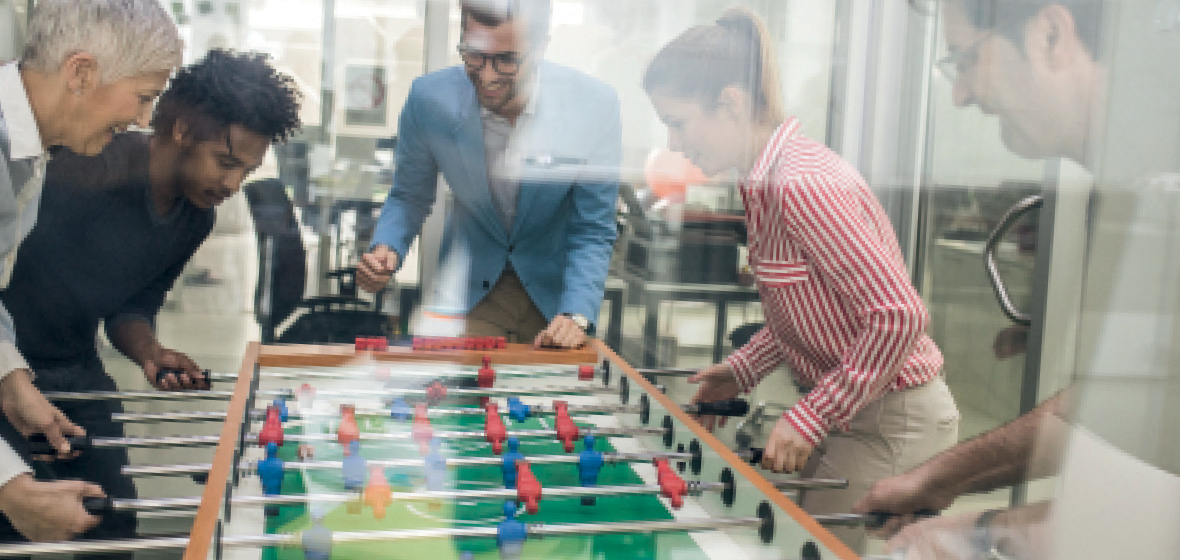Law and professional services firms are constantly coming up with new strategies to keep their workers happy, healthy and motivated. Trends for 2018 include mindfulness lessons, fun rooms, and even allocated nap areas. LSJ sent reporter KATE ALLMAN to test and review three emerging initiatives.
8.30am
Mindfulness lesson at Mindfulness Space, Sydney
When Emma Watson, Gwyneth Paltrow and Oprah all agree on something, you know it’s an idea with legs.
Hollywood icons have endorsed the idea of mindfulness since 2015, but only recently has it entered the corporate world. Businesses like Google run regular mindfulness sessions and the popular Headspace app is now worth more than AU$300 million.
Hollywood icons have endorsed the idea of mindfulness since 2015, but only recently has it entered the corporate world. Businesses like Google run regular mindfulness sessions and the popular Headspace app is now worth more than AU$300 million.en Emma Watson, Gwyneth Paltrow and Oprah all agree on something, you know it’s an idea with legs.
The Sydney office of Herbert Smith Freehills (HSF) jumped on board in 2017, introducing free teacher-led mindfulness sessions at 8.30am daily for anyone wishing to join.
I’ve always thought of “mindfulness” as a buzzword in the same category as irritating corporate jargon such as “capacity” or “reach out” (if one more person thinks they’ll “just reach out” I might put a javelin through my eyeball).
So, I visit psychologist and director of Mindfulness Space in Sydney, Paul Jozsef, to see whether Gwyneth and Oprah were right about this one. Jozsef runs two-hour mindfulness training sessions for businesses and has worked with corporates from the Commonwealth Bank, AMP and even the legal team at the Australian Government Department of Defence.
The first thing Jozsef explains is that mindfulness is not what I thought it was – it’s not about sitting around holding hands and singing kum ba yah, apparently. Instead, it’s a form of simple meditation that encourages you to focus on your thoughts in the present moment and be wary of how you choose to interpret situations. Jozsef gave the example of sitting in traffic while running late to work.
“You might be clenching your fists and reaching for the horn,” says Joszef. “Mindfulness teaches you to stop, think, and be aware of those body signals and thoughts. To recognise that you have the power to choose how you respond.”
Joszef runs me through a number of situations where mindfulness might be useful in daily life – coming home to your partner and kids after a stressful day at work, or responding to a passive-aggressive email from the boss. He offers me “STOP” as a useful acronym for responding in a mindful way. “S” for stop and take stock, “T” for take a breath, “O” for observe the situation, and “P” for proceed with a new possibility.
We run through a meditative exercise where Jozsef tells me to close my eyes and follow his directions to focus on how each body part felt as he mentions it, noticing the tension and relaxing each muscle as I concentrate on it. This exercise seems to take only one or two minutes, but when I open my eyes he tells me it had been closer to six.
How do I feel? Pretty fantastic, to be honest. My limbs feel like freshly-oiled cogs. My body is relaxed but my mind clear and alert.
I could count several daily situations where the STOP acronym would be useful – by slowing my reaction time down, breathing, analysing and choosing between a variety of possible responses. Some would require a meeting with HR later, others wouldn’t.
I wouldn’t endorse mindfulness as a panacea for depression in the legal profession, but I could see regular, short sessions doing wonders for stressed-out lawyers who rarely get a chance to detox away from screens, phones and family.
LSJ verdict: This cynic was converted. Judgment in favour.
Mindfulness teaches you to stop, think, and be aware of those body signals and thoughts. To recognise that you have the power to choose how you respond.
PAUL JOZSEF,
Director, Mindfulness Space
12pm
The “fun space” at PwC

One of the recent trends in office design is to add interactive spaces that encourage “collisions” – chance encounters and unplanned interactions between workers – to improve performance, social interaction and spark creativity.
Such spaces are being added to new-age offices around the world at companies like Google and Yahoo. Samsung’s US$300 million Silicon Valley headquarters was
built like a university campus for exactly
this reason.
Research shows such social interaction not only encourages ideas leading to innovation, it makes employees happier and encourages friendships that can help combat stress or burnout. A study led by Riordan and published in the Journal of Business Psychology in 1995 found that the mere opportunity for friendship at work increases employee happiness and job satisfaction. And a 2010 study by Gallup found that people who work with a best friend or “work wife” are seven times as likely to be engaged in their job.
I have heard whispers of a super-modern space designed to lure employees together since PwC first moved to its new Sydney offices in Barangaroo in June 2017. So I eagerly accept an invitation from PwC’s Head of Innovation and Technology, Debra Eckersley, to take a walk through PwC and check it out.
Enter: the “fun space”.
I’m hoping the firm didn’t spend too many billables thinking up an inventive name for this corner of floor space on level 14, which houses a ping pong table, Foosball, a PlayStation and a music room equipped with electronic drum kit, guitar and synthesiser keyboard.
When I arrive, the ping pong table is taken, and two young consultants are playing an animated game of FIFA in the PlayStation room. Eckersley assures me they are not actors – which becomes obvious when we ask to join their game and their first question (to Debra, a partner) is, “Who are you?”
The ping pong table frees up and I find myself laughing and hooting in a friendly match against Eckersley. For a minute, I completely forget I am on a work assignment. It’s easy to see how such simple activities could help employees socialise and recharge, without caffeine or alcohol.
Eckersley explains that the fun space is just one aspect of PwC’s broader “activity-based working” policy.
“We don’t assign desks and we encourage employees to get up and move around the firm, talk to other teams and share ideas,” says Eckersley.
“The evidence is that such communication and the requisite trust from managers is really positive and productive.”
Possibly the best part is that the space requires managers to trust their teams to divide up breaks and work time as they choose. That sort of trust probably does more for wellbeing than any PlayStation game could.
LSJ verdict: Grounds for appeal. (Especially for inter-floor ping pong competitions.)
We don’t assign desks and we encourage employees to get up and move around the firm, talk to other teams and share ideas.
DEBRA ECKERSLEY,
Head of Innovation and Technology, PwC
3pm
Nap pod at KPMG

In recent years it has become increasingly acceptable for professional workers to fall sleep on the job. A 1995 NASA study revealed that pilots who were allowed to nap for 40 minutes during the day (sleeping on average 26 minutes) “demonstrated vigilance performance improvements” and improved reaction time by up to 18 per cent compared to non-nappers.
Since then, multiple similar studies have shown that taking a power nap during the day can improve alertness, brain function, learning ability and productivity. One study published in Behavioural Brain Research in 2008 even showed that napping worked better than everyone’s favourite – caffeine – for improving motor skills and memory. It’s why high-profile companies such as Facebook, Uber and Procter & Gamble have installed designated napping “pods” in their US offices.
Professional services firm KPMG joined the nappers’ ranks in 2016, when its Sydney team relocated to new offices in Barangaroo Tower Three and installed a nap pod in a private “meditation room” on floor 37. I am given the “dream job” of testing the pod. In what might be a high point of my investigatory journalism career, I accept.
The nap pod looks like a cross between a business-class airline seat and one of those teeny Japanese capsule hotels made famous in Tokyo. (Interestingly, the Japanese have a word for strategically sleeping on the job: inemuri, which roughly translates to “sleeping while present”.)
The seat itself is seriously comfortable, and reclines backwards so I can sleep completely horizontally. A hood comes down over my head to shut out the light. There is a control system on the arm rest with a timer I can set to a maximum of 20 minutes – the optimum amount of time, according to US sleep research and author of Take a Nap! Change Your Life Sarah Mednick, necessary to refresh your brain without running into that groggy feeling of sleep inertia.
Another button plays calming flute and waterfall music – the sort they play when you’re getting a massage at a tropical island resort – to help me doze off. After 20 minutes, the music fades out and my seat vibrates to wake me up softly as it returns to the upright position. Tres relaxing.
Do I sleep? Well, no. But I do feel very relaxed, in a meditative way. Being able to lock myself in the room, which also comes with a shower and changing area for the full refresh where necessary (hello, all-nighters), was a nice way to get away from the stressful atmosphere of an office on multiple roving deadlines. I could definitely see lawyers using it in the pre-EOFY workload madness.
LSJ verdict: Quite literally the dream job. Judgment in favour.




